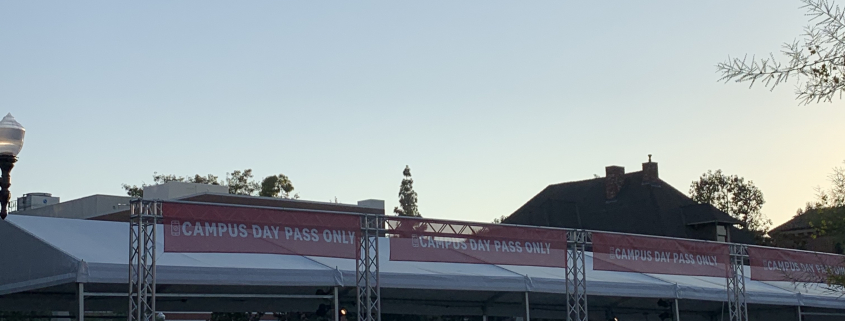Positivity rates see slight decline, UPC has fastest growing COVID-19 rate in LA County
Last week’s USC COVID-19 testing data has seen a slight decrease in positivity rates, according to testing data released online by the University Wednesday. However, USC Student Health and local public health officials anticipate an eventual increase from Labor Day weekend, Chief Health Officer Dr. Sarah Van Orman said in a student media briefing Tuesday. As of now, University Park Campus has the fastest growing rate of COVID-19 cases in Los Angeles County, Van Orman said.
In the week of Aug. 30, during which nearly 2,900 coronavirus tests were conducted, a total of 100 students and two employees tested positive for the coronavirus, according to the testing data. Of the 100 student cases, 44 students tested positive through external testing distributor Color’s asymptomatic surveillance testing with a 1.8% positivity rate. The remaining 56 students tested positive through USC Student Health’s testing for individuals who are symptomatic or exposed to the virus with a 23.0% positivity rate.
One employee tested positive in surveillance testing, and another employee tested positive through symptomatic or exposed testing.
According to Van Orman, the data from last week demonstrates a slight decrease in positivity rates from the week of Aug. 28, during which nearly 200 people tested positive. However, every other neighborhood in L.A. County has seen more significant decreases in COVID-19 rates. She and epidemiologists from the Keck School of Medicine studying community transmission within USC and beyond reached this conclusion after examining last week’s case rates.
Van Orman said that the accelerating community spread can partially be attributed to students moving to the area surrounding UPC for the fall semester.
“Anytime you have movements of people, but just for folks to be aware of, this area of the communities around here, this is a really significant amount of community transmission happening,” Van Orman said.
Even though there is a slight dip in positivity rates, however, Van Orman said Student Health is still “cautiously optimistic” from last week because there are still several reports of social activity off campus, where students are still getting exposed. Additionally, with Labor Day weekend now behind them, Van Orman said Student Health is anticipating an increase in positivity rates in the next few weeks.
“We, along with the county of course, are very concerned about the Labor Day weekend,” Van Orman said. “And if people [were] more socializing over the Labor Day weekend, we would see that in another two weeks, so we’re watching for that potential spike after Labor Day.”
According to Van Orman, the Los Angeles Department of Public Health shared in a briefing with higher education officials that at this rate, it is very unlikely that USC will be allowed to permit any increase in campus activity until after Thanksgiving at the earliest. UPC, which is already devoid of campus activity, will remain this way for the rest of the fall semester, Van Orman said.
“The activities are really driven by the county health orders, and of course, those are grounded in what we see as far as cases,” Van Orman said. “So I think for students that were thinking maybe we’ll have classes back this semester, … I think it’s really important that it’s looking very, very unlikely that we will have any more — any increase — in campus activity this semester.”
Looking ahead to the spring semester, Van Orman said that the University is working toward the goal of having an in-person semester. Due to the uncertainties brought about by the coronavirus pandemic and the upcoming flu season, Van Orman said the University will be requiring students who live on campus next semester to get a flu shot before they come back to L.A. following the holiday break.
However, Van Orman said faculty and staff are still thinking about contingency plans in case conditions make an in-person semester impossible.
“Everything we’re putting in place right now would have folks coming back through this whole period, though we’re asking unfortunately, it’s a challenge for faculty as well as for folks that they always have to have a contingency,” Van Orman said. “So while we believe at this point, we’re going to be back … It’s really not driven by a USC decision, it’s going to be driven by the local public health conditions.”

